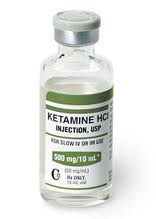Repeated Ketamine Reduces PTSD and Depression in the Short Term
In a 2018 open study by C. Sophia Albott and colleagues in the Journal of Clinical Psychiatry, veterans with post-traumatic stress disorder (PTSD) and a simultaneous diagnosis of major depression were treated with six infusions of intravenous ketamine over a 12-day period (Mondays, Wednesdays, and Fridays for two weeks).
Ketamine produced large improvements in both conditions. The remission rate was 80.0% for PTSD and 93.3% for depression. The median time to first relapse after the treatment was 41 days for PTSD and 20 days for depression.
One side effect of ketamine was that dissociative symptoms increased temporarily with repeated infusions. PTSD symptoms did not worsen among those participants taking ketamine.
The study was intended to evaluate the efficacy, safety, and durability of repeated ketamine infusions. Ketamine has been used in emergency rooms to rapidly treat depression and suicidality, but the effects of a single infusion fade within days. Albott and colleagues reported that this treatment scenario with multiple ketamine infusions produced rapid results that lasted longer than single ketamine infusions.
Editor’s Note: While this study found that repeated ketamine infusions were safe, it is possible that long-term use may lead to addiction. Researcher Nolan R. Williams and colleagues reported in a 2018 article in the American Journal of Psychiatry that ketamine works via activation of the opiate receptor. The drug naloxone, which rapidly reverses opiate overdose, completely blocked ketamine’s antidepressant effects.
Intranasal Ketamine for Bipolar Disorder
 An in-press article due out in January 2018 by Demitri F. Papolos and colleagues in the Journal of Affective Disorders reports that intranasal ketamine delivered every three to four days reduced symptoms of bipolar disorder in 45 teens (aged 16 years on average). The teens treated in one private practice had the ‘fear-of-harm’ subtype, which in addition to bipolar symptoms is characterized by treatment resistance, separation anxiety, aggressive obsessions, disordered sleep, and poor temperature regulation.
An in-press article due out in January 2018 by Demitri F. Papolos and colleagues in the Journal of Affective Disorders reports that intranasal ketamine delivered every three to four days reduced symptoms of bipolar disorder in 45 teens (aged 16 years on average). The teens treated in one private practice had the ‘fear-of-harm’ subtype, which in addition to bipolar symptoms is characterized by treatment resistance, separation anxiety, aggressive obsessions, disordered sleep, and poor temperature regulation.
The repeated administration of ketamine produced long-lasting positive results, improving bipolar symptoms as well as social function and academic performance. Many participants reported via survey that they were much or very much improved after being treated for durations ranging from 3 months to 6.5 years. Side effects were minimal and included sensory problems, urination problems, torso acne, dizziness, and wobbly gait.
The ketamine was delivered to alternating nostrils via 0.1 ml sprays that included 50–200 mg/ml of ketamine in 0.01% benzalkonium chloride. Patients were instructed to increase the dosage just up until it became intolerable and then repeat the last tolerable dose every three to four days. Final doses ranged from 20–360 mg. The mean dose was 165 mg (plus or minus 75 mg) delivered every 3 days.
Papolos and colleagues called for placebo-controlled clinical trials based on the positive results from this open study.
An Overview of Ketamine for Treatment-Resistant Depression
 A 2017 series of articles by researcher Chittaranjan Andrade in the Journal of Clinical Psychiatry reviews the last 10 years of research on ketamine, the anesthetic drug that in smaller doses (0.5 mg/kg of body weight) can bring about rapid antidepressant effects. Ketamine is typically delivered intravenously (though it can also be delivered via inhaler, injected under the skin or into muscles, and least effectively by mouth). Ketamine can improve depression in less than an hour, but its effects usually fade within 3 to 5 days. Repeating infusions every few days can extend ketamine’s efficacy for weeks or months.
A 2017 series of articles by researcher Chittaranjan Andrade in the Journal of Clinical Psychiatry reviews the last 10 years of research on ketamine, the anesthetic drug that in smaller doses (0.5 mg/kg of body weight) can bring about rapid antidepressant effects. Ketamine is typically delivered intravenously (though it can also be delivered via inhaler, injected under the skin or into muscles, and least effectively by mouth). Ketamine can improve depression in less than an hour, but its effects usually fade within 3 to 5 days. Repeating infusions every few days can extend ketamine’s efficacy for weeks or months.
Andrade cited a 2016 meta-analysis of nine ketamine studies by T. Kishimoto and colleagues in the journal Psychological Research. The meta-analysis found that compared to placebo, ketamine improved depression beginning 40 minutes after IV administration. Its effects peaked at day 1 and were gone 10–12 days later. Remission rates were better than placebo starting after 80 minutes and lasting 3–5 days.
Several studies have found that ketamine also reduces suicidality.
Andrade reported that both effectiveness and side effects seem to be dose-dependent within a range from 0.1 mg/kg to 0.75 mg/kg.
Side effects of ketamine are typically mild and transient. A 2015 study by Le-Ben Wan and colleagues (also in the Journal of Clinical Psychiatry) that Andrade cited reported that in 205 sessions of ketamine administration, the most common side effects were drowsiness, dizziness, poor coordination, blurred vision, and feelings of strangeness or unreality. The feelings of unreality (dissociative effects) diminish with repeated infusions. Heart and blood pressure may also temporarily increase as a result of ketamine administration.
One study found that ketamine could speed up and add to the effects of the selective serotonin reuptake inhibitor (SSRI) antidepressant escitalopram (Lexapro). A meta-analysis of 10 randomized controlled trials found that ketamine did not improve the effects of electroconvulsive therapy.
Ketamine has some history as a recreational club drug (sometimes known as ‘K’ or ‘special K’), and can be misused or abused.
While there have been many studies of ketamine’s antidepressant effects, Andrade concludes that none is of a standard to justify US Food and Drug Administration approval for the drug. It is hoped that larger, more rigorous trials will be completed in the next few years. However, ketamine is already being used widely to treat treatment-resistant unipolar and bipolar depression.
Oral Ketamine Relieves Depression in Patients with Chronic Pain
Ketamine, which is used as an anesthetic at higher doses, can also relieve depression within hours when delivered intravenously. A 2016 study by Morteza Jafarinia and colleagues in the Journal of Affective Disorders suggests that oral ketamine may be helpful in the treatment of mild to moderate depression in people with chronic pain.
The study compared 150mg daily doses of oral ketamine to 150mg daily doses of the anti-inflammatory pain reliever diclofenac over 6 weeks. When interviewed at week 3 and week 6, the ketamine group reported significantly fewer symptoms of depression than the diclofenac group.
Mouse Study Shows That Ketamine Metabolite May Treat Depression with Fewer Side Effects
The drug ketamine has been used intravenously for years to rapidly treat depression, because it can take effect within hours. Unfortunately, its antidepressant effects fade in 3–5 days, and it has some unpleasant side effects. In larger doses ketamine is used as an anesthetic and sometimes as a club drug, for its ability to induce hallucinations and dissociation. It can be addictive as well.
A 2016 animal study by Todd Gould and colleagues published in the journal Nature identified a byproduct of ketamine that may be able to provide the drug’s benefits without its side effects.
When the body breaks down ketamine, it produces several chemicals that are known as ketamine metabolites. The researchers found that one of these, called hydroxynorketamine, reversed a depression-like state in mice, without producing the side effects that would be expected of ketamine.
Gould and colleagues also determined that blocking the transformation of ketamine into hydroxynorketamine prevented ketamine’s antidepressant effects.
Ketamine’s unpleasant anesthetic and dissociative effects result from the blockade of a particular receptor for the neurotransmitter glutamate (the NMDA glutamate receptor). Researchers originally thought that the NMDA blockade was linked to ketamine’s antidepressant effects, but this appears not to be the case. Instead, hydroxynorketamine seems to activate a different type of glutamate receptor, the AMPA receptor.
Gould and colleagues plan to test hydroxynorketamine in humans soon. Because it has already been present in the human body following ketamine administration, they expect it to be safe.
IV Ketamine 2 or 3 Times Per Week Improves Depression
We have written many times before about intravenous ketamine as a fast-acting antidepressant treatment that can produce results within hours. Unfortunately, these quick results tend to fade within a few days. Current research is focused on possible ways of extending ketamine’s antidepressant effects.
A 2016 article by Jaskaran B. Singh and colleagues in the American Journal of Psychiatry reported that giving depressed patients infusions of ketamine (0.5mg/kg of body weight) twice or three times per week improved their depression compared to placebo over a period of up to 2 weeks.
Side effects included headache, anxiety, dissociation, nausea, and dizziness. The dissociation was temporary and improved with repeated dosing.
In Mice, Ketamine Prevents Stress From Turning Into Depression
Stress increases the risk of psychiatric illnesses such as major depression and post-traumatic stress disorder. Not everyone who experiences stress goes on to develop these illnesses, though. Researchers are currently trying to find out why, exploring treatments that might increase resilience and prevent mental illnesses.
Animal research is often used to study depression. Mice exposed to certain stressors behave in ways that resemble human depression—like giving up faster when they’re forced to tread water, or withdrawing from activities they once enjoyed, like eating sucrose. In a recent study by researcher Christine Denny and colleagues, mice were injected with either saline or ketamine, a rapid-acting antidepressant, and one week later they were exposed to triggers that typically produce a depressive response. Mice who received the saline injection still got depressed when, for example, they were repeatedly forced to confront a dominant mouse. But mice who received ketamine injections did better, maintaining their motivation and not showing signs of depressive behavior following the stress. The researchers concluded that ketamine may have a protective effect against stress.
Editor’s Note: These results are remarkable because ketamine’s effects are typically short-lived.
Intranasal Ketamine Produces Long-Lasting Antidepressant Effects
It has been known for years that ketamine, an anesthetic at higher doses, can quickly produce anti-depressant effects when delivered intravenously. However, these effects typically last only a few days. New research is exploring how to extend the antidepressant effects of ketamine.
Researcher Ella Daly and colleagues recently compared a form of ketamine called esketamine, this time delivered intranasally, to placebo in people with tough-to-treat depression that had resisted other treatments. Daly and colleagues randomized participants to receive one of three different doses of intranasal esketamine (28mg, 56mg, or 84mg) or placebo twice a week.
All of the doses of intranasal esketamine improved participants’ depression compared to placebo, with higher doses producing more sustained improvement. After the 2-week double-blind study, participants could choose to continue (or begin) taking esketamine for another nine weeks, tapering dosage slowly from twice a week to once every other week by the end. The participants were then monitored for another eight weeks. The intranasal esketamine doses they received led to sustained improvements in depression that lasted, in some cases, through the eight weeks following their final dose.
Side effects were not severe. Ketamine can produce dissociative sensations, but these tended to dissipate with two hours of administration.
Johnson and Johnson Pharmaceuticals funded this research, which was presented at a scientific meeting in 2015, and they plan to continue researching intranasal esketamine in the hopes of getting Food and Drug Administration approval for the drug.
Ketamine: Equal Efficacy When Given With Lithium Or Valproate
Studies of rodents with depression-like behaviors revealed that the combination of low (sub-therapeutic) doses of lithium and infusions of ketamine produced antidepressant-like effects. Researchers believed this might mean that in humans, lithium might have a unique effect potentiating the effects of ketamine.
In a small study by Mark J. Niciu presented at the 2015 meeting of the Society for Biological Psychiatry, patients with bipolar depression taking lithium or valproate mood stabilizers were given ketamine infusions or control infusions. In the 23 patients taking lithium and the 13 taking valproate, ketamine’s antidepressant effects were significantly better than placebo, but there was no difference between lithium and valproate with regard to these antidepressant effects. These preliminary data in a small number of subjects do not support the proposition that lithium augments the effects of ketamine in depression.
Ketamine Temporarily Reduces Suicidal Thoughts
Intravenous ketamine can bring about rapid improvement in depressive symptoms among people with treatment-resistant depression. Because of its rapid effects, which can appear after only two hours, ketamine is being investigated as a treatment for people with suicidal thoughts.
At the 2015 meeting of the Society of Biological Psychiatry, Laili Soleimani and colleagues presented a poster about their recent double blind, randomized, controlled pilot study of ketamine inpatients and outpatients who scored highly on a measure of suicidal ideation. The 24 participants were randomized to receive either a single intravenous infusion of ketamine (0.5mg/kg) or a single infusion of midazolam (0.045 mg/kg), which shares ketamine’s anxiety-reducing effects but does not have antidepressant effects. They reported suicidal thoughts at 24 hours post-infusion, 48 hours, 72 hours, and 7 days. At 48 hours, those who received ketamine reported significantly reduced suicidal ideation compared to those who received midazolam, but this effect was no longer significant at the 72-hour mark.
The findings show that ketamine can briefly reduce suicidal ideation, and that the treatment is safe and tolerable for patients. This pilot study paves the way for further study of ketamine to reduce suicidal thinking in people who are at high risk for suicidal behavior.









